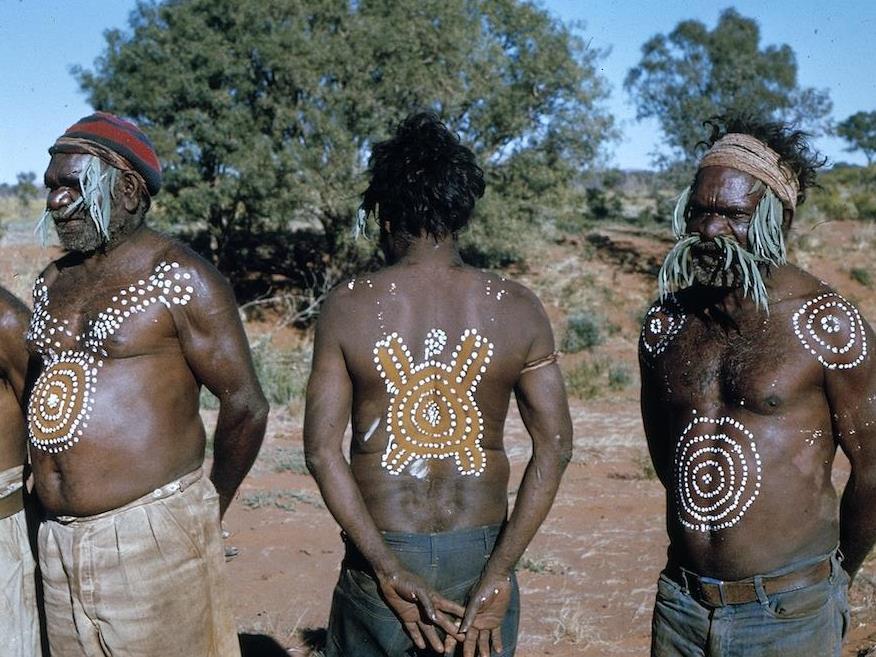Left to right: Nosepeg Tjupurrula, Uta Uta Tjangala (painted back) and George Tjangala west of Papunya, June 1972. Image: Llewellyn Parlette. Courtesy: AIATSIS, Llewellyn Parlette Collection.
Popular understanding of early painting at Papunya distorts the truth. This popular narrative starts with an art teacher by the name of Geoffrey Bardon, alone in the desolate wilderness, who travels to the remote Aboriginal community of Papunya. The story suggests that Bardon encouraged a group of local men to begin painting, instigating this important moment in contemporary Aboriginal art.
‘It was much more nuanced and complex than that,’ said Luke Scholes, Curator of Aboriginal Art the Museum and Art Gallery of Northern Territory (MAGNT), who has spent the last four years researching the details of how this art movement actually emerged.
‘Geoffrey Bardon actually came upon an already existing art movement and an already highly operational, highly entrepreneurial group of artists. In part Tjunguṉutja seeks to reclaim their agency in the process of the making of the art movement,’ said Scholes.
This research informs the current exhibition Tjunguṉutja: from having come together, on at MAGNT from 1 July to 18 February.
MAGNT houses the most significant collection of art from the early Papunya artists, including one sixth of the works produced between 1971-1972. ‘The driving force behind this exhibition is MAGNT sharing a cornerstone of our collection with the community from where the art came, and also the broader public,’ said Scholes.
‘Because this collection hasn’t been exhibited as much as we would have ideally liked since we acquired works, it really is the first time people, including Aboriginal community members, have had the opportunity to experience the paintings.’
The exhibition is co-curated by five Indigenous curators who are all senior men from the Western Desert community; Long Jack Phillipus Tjakamarra, Michael Nelson Jagamarra AM, Sid Anderson, Bobby West Tjupurrula, and Joseph Jurrah Tjapaltjarri.
TJUNGUṈUTJA: from having come together from MAGNT on Vimeo.
‘We’ve been working on this for three years and it has involved a lot of driving. I’ve been travelling out to communities as far as 700 kilometres west of Alice Springs to consult with not just my co-curators, but also the family members of those original artists,’ said Scholes.
‘The first part of the process was in a sense about repatriating a lot of information back to communities. A lot of people knew we have a significant collection, but they didn’t necessarily know what was in our collection so it was really about taking these paintings and the descriptions that were attached, which were occasionally minimal from back in 1971-72, and repatriating that information back to the community and then working with people in a certain way, ensuring that its revisited in a culturally safe manner.’
‘We have a number of paintings that were deemed inappropriate for public display because of the painted depiction of men’s ceremonial scenes and paraphernalia. We wanted to make sure that whatever we display was safe and has input from the Aboriginal community.’
The true genesis
The art book accompanying the exhibition contains rare unpublished photographs and a series of scholarly essays, including a Q&A that contradicts the popular narrative of Geoffrey Bardon. It identifies a series of ceremonies that took place prior to the art movement emerging as the moment where different language and cultural groups came together. ‘It was really through their sharing of ceremony, between 1969 and into the 1970s, that really laid the foundation for the art movement to begin,’ said Scholes.
‘We really try to give a voice to community members who haven’t been given the opportunity to have one until now. We have an 84 minute audio visual presentation in the exhibition space as well, which provides family members of those founding artists the opportunity to tell their side of the story but also to give us some personal information about those old fellas as well.’
For more information visit http://www.magnt.net.au/tjungunutja





